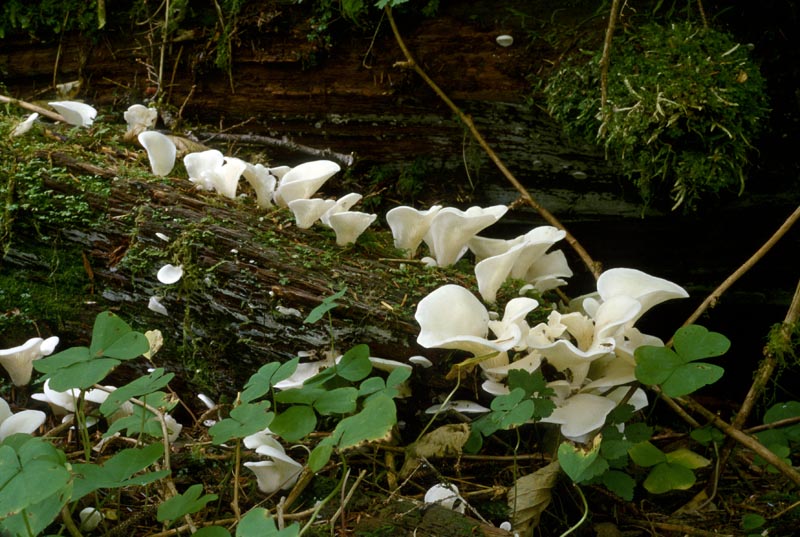
© Steve Trudell
Danny’s DNA Discoveries – Phyllotopsidineae "oysters" of the PNW
by Danny Miller
Click here for my Pictorial Key to all white spored "oysters".
|
|
Danny’s DNA Discoveries – Phyllotopsidineae "oysters" of the PNW
Click here for my Pictorial Key to all white spored "oysters". |
|
Introduction
This relatively basal sub-order of the Agaricales has a number of very thin club mushrooms, probably representing an ancestral state to gills, but mostly consists of wood-inhabiting "oyster" shaped white spored gilled mushrooms (with a lateral or absent stem). This sub-order also appears to contain the "normal" non-oysters Tricholomopsis (on wood) and Aphroditeola (with the derived trait of growing on the ground, something not common until the more derived clades). White spored oysters appear in other more derived sub-orders as well. My pictorial key link above covers them all. Notably absent from the ones in this sub-order are the official edible oyster mushrooms themselves. Those are in the Pleurotineae. Pleurocybella - angel wings. Phyllotopsis - a unique, beautiful stinky, fuzzy orange medium sized stemless oyster Sarcomyxa - a beautiful "oyster" with green and orange colours. A large multi-gene study showed that Sarcomyxa properly belongs in its own sub-order, one of many relatively basal sub-orders of the Agaricales containing "oyster" mushrooms. 'Panellus' mitis - I get high support for this being in the same family. It is a little white oyster with a small, stubby, downy lateral stem, unique for its peelable cap cuticle and gill edge. One possible genus name for it is to elevate its section from within Panus to genus, and call it Mitellus mitis n.p. Tectella - a unique little brown, stemless, veiled white spored "oyster" mushroom (growing on wood with a lateral or absent stem). It sometimes appears near the Tricholomatineae or the Pleurotineae sub-orders, with no support. abundant common uncommon rare - colour codes match my Pictorial Key and are my opinions and probably reflect my bias of living in W WA. Rare species may be locally common in certain places at certain times. |
|
Summary of Interesting Results
Here are some of the newest, most interesting results of the study:
|
|
Pleurocybella (Phyllotopsidaceae)
Pleurocybella 'porrigens PNW01' - angel wings. Pure white, shoehorn shaped and stemless growing on conifers. Often eaten even though it was responsible for a bunch of fatalities in Japan of people with kidney problems. Our local sequences are 1.5% different than in the EU so ours may need a new name. Two Japanese species are different from the EU by 2% and 6% respectively, so it's even possible that the Japanese toxin is unique to that area. This family also contains some very thin club mushrooms. unsequenced Pleurocybella 'porrigens PNW01' © Steve Trudell |
|
Phyllotopsis (Phyllotopsidaceae) Phyllotopsis 'nidulans IN01' - A unique, beautiful stinky, fuzzy orange medium sized stemless oyster from both conifers and hardwoods. Panellus stipticus is similar but stemmed, bitter tasting and not stinky. Alaska sequences seem to be the real EU species, but the east coast, Arizona and the PNW have a sister species 3% different in ITS. Some of our collections were reported to smell worse than those in Europe. This family also contains some very thin club mushrooms. Phyllotopsis 'nidulans IN01' © Michael Beug |
|
Sarcomyxa (Sarcomyxaceae)
Sarcomyxa serotina EU - The "late oyster", another unique, beautiful medium-sized late season oyster usually from hardwoods, with a green and orange cap and a stubby lateral orange stem with black dots. It has a somewhat viscid cap and gelatinous flesh. Local sequences are only a single bp and indel different than a bunch of EU sequences. Sarcomyxa PNW01 - a single collection from WA on oak looks like a very robust Sarcomyxa with a very thick stem and a purple cap with bright yellow areas. It is also known from CA on conifer wood with an orange-brown cap. Sarcomyxa serotina © Andrew Parker, S. PNW01 © Michael Beug |
|
'Panellus' ('Mitellus') mitis (Sarcomyxaceae)
'Mitellus' cf mitis n.p. ('Panellus' mitis) EU - this little white capped (when fresh, then brownish), white spored oyster with a short, stubby, downy lateral stem, is unique for its peelable cap cuticle and gill edge. The gill edge is shown under the microscope to explain how it can peel off. Scytinotus longinquus is viscid capped and neither the cap nor gill edge peel off. Our one local WA sequence (from hardwood, whereas the species is most often found on conifers) is 2 bp and 2 indels different than EU sequences. One of those indels is of length 16, but that could have happened in one event, so for now I'm assuming ours is the true species. unseuenced 'Panellus' mitis © Fred Rhoades, 'Panellus' mitis with gelatinized gill edge © Danny Miller |
|
Tectella (Sarcomyxaceae) Tectella cf patellaris EU - the unique veil on this all brown, little white spored oyster is only easily seen when very young and breaks off leaving only a roughness around the edge, but the species can still be recognized by the deep cup shape required so the veil can form as a flat surface. It is somewhat viscid when young and stemless and often attached to hardwood from somewhere in the middle of the cap! We don't have EU sequences to compare to, but east and west coast sequences differ by 1 bp in ITS1 and 4 bp and 1 indel in ITS2, so it could go either way whether or not they are different species, which means its anybody's guess if we will have the real EU species here or if it will need a new name. We need EU collections. unsequenced Tectella patellaris © Jim Ginns |